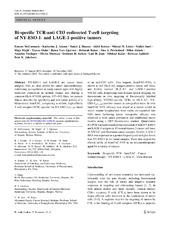Bi-specific TCR-anti CD3 redirected T-cell targeting of NY-ESO-1- and LAGE-1-positive tumors
McCormack, Emmet; Adams, Katherine J.; Hassan, Namir J.; Kotian, Akhil; Lissin, Nikolai M.; Sami, Malkit; Mujic, Maja; Osdal, Tereza; Gjertsen, Bjørn Tore; Baker, Deborah; Powlesland, Alex S.; Aleksic, Milos; Vuidepot, Annelise; Morteau, Olivier; Sutton, Deborah H.; June, Carl H.; Kalos, Michael; Ashfield, Rebecca; Jakobsen, Bent K.
Peer reviewed, Journal article
Published version
Permanent lenke
https://hdl.handle.net/1956/6397Utgivelsesdato
2012-12Metadata
Vis full innførselSamlinger
Originalversjon
https://doi.org/10.1007/s00262-012-1384-4Sammendrag
NY-ESO-1 and LAGE-1 are cancer testis antigens with an ideal profile for tumor immunotherapy, combining up-regulation in many cancer types with highly restricted expression in normal tissues and sharing a common HLA-A*0201 epitope, 157–165. Here, we present data to describe the specificity and anti-tumor activity of a bifunctional ImmTAC, comprising a soluble, high-affinity T-cell receptor (TCR) specific for NY-ESO-1157–165 fused to an anti-CD3 scFv. This reagent, ImmTAC-NYE, is shown to kill HLA-A2, antigen-positive tumor cell lines, and freshly isolated HLA-A2- and LAGE-1-positive NSCLC cells. Employing time-domain optical imaging, we demonstrate in vivo targeting of fluorescently labelled high-affinity NYESO-specific TCRs to HLA-A2-, NYESO- 1157–165-positive tumors in xenografted mice. In vivo ImmTAC-NYE efficacy was tested in a tumor model in which human lymphocytes were stably co-engrafted into NSG mice harboring tumor xenografts; efficacy was observed in both tumor prevention and established tumor models using a GFP fluorescence readout. Quantitative RT-PCRwas used to analyze the expression of both NY-ESO-1 and LAGE-1 antigens in 15 normal tissues, 5 cancer cell lines, 10 NSCLC, and 10 ovarian cancer samples. Overall, LAGE-1 RNA was expressed at a greater frequency and at higher levels than NY-ESO-1 in the tumor samples. These data support the clinical utility of ImmTAC-NYE as an immunotherapeutic agent for a variety of cancers.
Beskrivelse
Electronic supplementary material The online version of this article (doi:10.1007/s00262-012-1384-4) contains supplementary material, which is available to authorized users.

